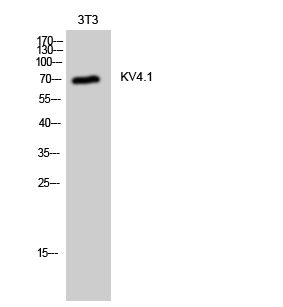KV4.1 Polyclonal Antibody
- Catalog No.:YT2513
- Applications:WB;IHC;IF;ELISA
- Reactivity:Human;Mouse
- Target:
- KV4.1
- Gene Name:
- KCND1
- Protein Name:
- Potassium voltage-gated channel subfamily D member 1
- Human Gene Id:
- 3750
- Human Swiss Prot No:
- Q9NSA2
- Mouse Gene Id:
- 16506
- Mouse Swiss Prot No:
- Q03719
- Immunogen:
- The antiserum was produced against synthesized peptide derived from human KCND1. AA range:558-607
- Specificity:
- KV4.1 Polyclonal Antibody detects endogenous levels of KV4.1 protein.
- Formulation:
- Liquid in PBS containing 50% glycerol, 0.5% BSA and 0.02% sodium azide.
- Source:
- Polyclonal, Rabbit,IgG
- Dilution:
- WB 1:500 - 1:2000. IHC 1:100 - 1:300. ELISA: 1:20000.. IF 1:50-200
- Purification:
- The antibody was affinity-purified from rabbit antiserum by affinity-chromatography using epitope-specific immunogen.
- Concentration:
- 1 mg/ml
- Storage Stability:
- -15°C to -25°C/1 year(Do not lower than -25°C)
- Other Name:
- KCND1;Potassium voltage-gated channel subfamily D member 1;Voltage-gated potassium channel subunit Kv4.1
- Observed Band(KD):
- 70kD
- Background:
- This gene encodes a multipass membrane protein that comprises the pore subunit of the voltage-gated A-type potassium channel, which functions in the repolarization of membrane action potentials. Activity of voltage-gated potassium channels is important in a number of physiological processes, among them the regulation of neurotransmitter release, heart rate, insulin secretion, and smooth muscle contraction. [provided by RefSeq, Aug 2013],
- Function:
- domain:The segment S4 is probably the voltage-sensor and is characterized by a series of positively charged amino acids at every third position.,function:Pore-forming (alpha) subunit of voltage-gated rapidly inactivating A-type potassium channels. May contribute to I(To) current in heart and I(Sa) current in neurons. Channel properties are modulated by interactions with other alpha subunits and with regulatory subunits.,similarity:Belongs to the potassium channel family. D (Shal) subfamily.,subunit:Homotetramer or heterotetramer with KCND2 and/or KCND3. Associates with the regulatory subunits KCNIP1, KCNIP2, KCNIP3 and KCNIP4 (By similarity). Interacts with DPP10.,tissue specificity:Widely expressed. Highly expressed in brain, in particular in cerebellum and thalamus; detected at lower levels in the other parts of the brain.,
- Subcellular Location:
- Membrane; Multi-pass membrane protein. Cell projection, dendrite .
- Expression:
- Widely expressed. Highly expressed in brain, in particular in cerebellum and thalamus; detected at lower levels in the other parts of the brain.
- June 19-2018
- WESTERN IMMUNOBLOTTING PROTOCOL
- June 19-2018
- IMMUNOHISTOCHEMISTRY-PARAFFIN PROTOCOL
- June 19-2018
- IMMUNOFLUORESCENCE PROTOCOL
- September 08-2020
- FLOW-CYTOMEYRT-PROTOCOL
- May 20-2022
- Cell-Based ELISA│解您多样本WB检测之困扰
- July 13-2018
- CELL-BASED-ELISA-PROTOCOL-FOR-ACETYL-PROTEIN
- July 13-2018
- CELL-BASED-ELISA-PROTOCOL-FOR-PHOSPHO-PROTEIN
- July 13-2018
- Antibody-FAQs
- Products Images

- Western Blot analysis of 3T3 cells using KV4.1 Polyclonal Antibody

- Western blot analysis of lysates from NIH/3T3 cells, using KCND1 Antibody. The lane on the right is blocked with the synthesized peptide.



